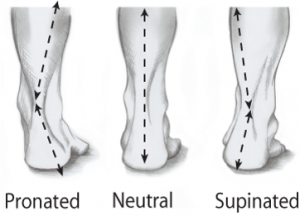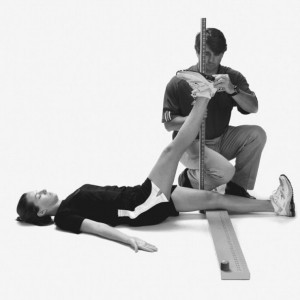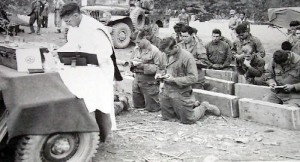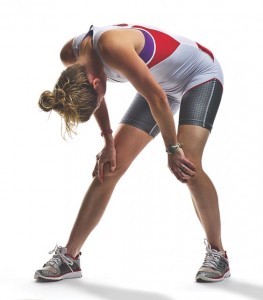On Tuesday and Wednesday this week Okanagan Peak Performance Inc presented the Knee Solution Seminar. Below is a recap of the main points from this presentation. Why We Have Knee ProblemsIn order to have the healthiest knees we need to make sure the joint sits in the proper place. And to do this properly we started at the ground looking at the foot. If the foot sits in a pronated position, with a collapsed arch, this will cause the knee to fall inward. And if we have a supinated foot, or high arch, the foot will roll out to the outside. [caption id="attachment_5344" align="aligncenter" width="300"] Image showing a pronated, neutral and supinated foot position. We ran through a couple of drills showing the attendees how to self-assess the positioning of the foot. One drill involves placing the thumb and index finger on the same foot just below the malleolus. If your thumb and index finger are on the bumps on the sides of the ankle you're too high. Slide the fingers lower until them feel soft tissue. From this position roll the ankle inward. On which finger do you feel more pressure? What happens to the arch? What happens to the knee? Now repeat this drill and roll the ankle outward. Which finger feels more pressure? What happens to the arch? And where does the knee go? The goal for this drill is find the position where there is 50-50 pressure on the thumb and index finger. Once the foot is set in this position the knee will line up optimally as well. The other way we look at foot position was by considering the plantar surface (bottom of the foot). On the bottom of the foot imagine a triangle. And the three lines of this triangle are from the pad under...
Back Spasms to Squats in 20 Min
The other day a client walked past the front desk and said 'I'm done. My back is spasming and I can't train today'. I could see the pain and disappointment in this young athlete's eyes. She was a dedicated athlete and was upset with only the physical pain but also with the thought of not being able to move without pain. I asked her if she has a few minutes to check what was wrong. I should clarify that this wasn't an attempt to diagnose an injury. Instead I wanted to take a look at her movement patterns to see how she was moving and how this might be affecting her low back. The first thing we looked at was her overhead squat pattern. This was a bodyweight assessment and she was ok to get into the set up position. However as she began to squat she winced and said her back spasmed. I asked her if it hurt standing, when she began to descent or at a certain depth. She said it was at a certain depth. The next thing I had her do was get on the ground on her back to see if she could hug her knees to her chest. She could and it didn't aggravate her back. This was interesting to note because she couldn't achieve the same knee and hip flexion from a standing position. After the knee hug test I asked her to keep both knees straight and lift one leg as high as she could. She raised one leg a few inches off the ground and repeated the same for the other leg. This was unusual as typically we look to see 80 degrees of hip flexion on this test. Right now this athlete was demonstrating 10 degrees. Maybe. When I asked the...
A Great Drill For Low Back Pain
Low back pain is something almost everybody experiences at some point in their life. And once we've suffered through some low back pain we usually want to know what caused the pain and what to do about ensuring it doesn't happen again. And while there may be a variety of causes and types of low back pain there are some things in common to all. First of all, in order to prevent future episodes of low back pain we want to to ensure we have a solid foundation and can move through an optimal range of motion. To look at the first condition for a solid foundation we need to consider our posture. Do the joints of the body stack evenly like pieces of lego? Or are there some areas where they are deviations from optimal alignment and smooth curves? This may get tricky for the lay person because how are they to know what is optimal? And often times manuals and references used technical terms which can confuse even people who work in the fitness industry. In this case I like the way Dan John describes the relationship of the hips and pelvis with the torso. He has described this as a box (torso) sitting on a bowl of water (hips & pelvis). Does the box sit squarely on the bowl of water? And is any water leaking out of the bowl of water? If so, is water leaking out of the front of the bowl (anterior tilt) or the back of the bowl (posterior tilt)? If the rib cage is flared or tilted up than the box is not sitting squarely on the bowl of water. And if we are spilling water than we know how to correct this problem as well. The solution comes via the kneeling plank. It...
Stand Tall for Better Recovery
- Chris Collins
- Fitness
- Training
- Work-Out Recovery
- 1540 Hits
- 0 Comments
-
One of the great things about coaching is that there are plenty of opportunities to train. We never have an excuse for access to equipment. While it's nice to have access to kettle bells, Olympic platforms and anything that makes a session more enjoyable the truth is all we need is gravity for an effective workout. But besides that we're always getting exposed to new training methodologies and research. And so this can become our lab. This is the place we test our theories, see what works, what doesn't and how to make any changes if necessary. And just as the best part of our job is the people we get to work with this place is great in that we can usually find another coach to rope into a training session. Megan, Kayla, Graeme and Jordy all place a high value on training and are always up for the challenge as well. Recently when training with Megan and Kayla I noticed they were doing something at the end of each set. And it's something most of us do usually out of habit. [caption id="attachment_4253" align="aligncenter" width="263"] Kayla or Megan? Take your pick If this were a live presentation and I asked for a show of hands 'who bends over and puts there hands on their knees to recover?' almost 100% of the room would be reaching skyward. But there's a couple of problems with this. First of all let's take a look at what an ideal posture should be. And compare this to the common forward head posture many people have. [caption id="attachment_4254" align="aligncenter" width="300"] Ideal or forward head posture Now if you look at the bottom arrow of the picture on the right you can imagine this is close to where the pelvis would sit. The picture on the...
3 takeaways from Hawaii
I'm just finishing a vacation with my family in Hawaii. And it's been a great week to spend time together and relax. But even though I'm on vacation there are still times when I notice little things that will help me as a coach. Below are the 3 takeaways from my time in Hawaii. Slow down to learnIt seems as though everything in life is automatic and has to happen now. We can stream pretty much anything online without having to wait, do our banking in our pyjamas and have learned that we don't need to wait. While I was snorkelling near Waikoloa I would float over a some corral and not notice too much. I could very easily have changed directions, looked elsewhere or switched gears and grabbed a boogie board instead. But I waited and just floated there for a second. And a variety of life came out from hiding. Fish that had tucked under the corral or stopped moving to blend in with it assumed everything was safe. The amount of life, colour and activity that presented itself was amazing. It's all because I gave it 5 seconds to develop for me. Do the same thing with your training. Don't rush things. Be patient. Really learn to listen to your body, to the movement and to notice the subtle aspects of your training. Because if you're always in a race you'll miss a lot of the little, very important lessons right in front of you. There is always lots to improveAs you become more patient with your training you will notice more things that you can improve. Take breathing as an example. The complex where we were staying at had a gym. And by gym I mean a 10x10 foot room with a treadmill, bike, elliptical and a...
6 Benefits of Proper Diaphragmatic Breathing
- Chris Collins
- Fitness
- 2044 Hits
- 4 Comments
-
There's been lots of discussion recently regarding diaphragmatic breathing. Some people are aware of the benefits of this type of breathing and others are probably thinking 'what's the big deal?' At a recent conference in California one of the more veteran presenters at a round table discussion said he didn't understand the big deal everyone was making about breathing. And I can kind of see his point. Sometimes we can get caught up in the minutiae of training and lose focus on the big picture. But in this case breathing is the basis for everything we do. It provides feedback as to the state of our nervous system, the effectivenss of our gas exchange and whether we are leaving anything on the table during athletic performance. But it's more than that. Because 20, 30 or 40 years ago we didn't sit and drive as much as do today. And we didn't specialize in one sport or activity as much as we see going on today. And maybe we lived simpler lives and didn't carry all of the stress that we do now in 2013. So we would therefore expect there to be differences in our posture, our mobility, the type and severity of the injuries we suffer as well as how much stress we are under. As a result there would be benefits to ensuring that we are breathing properly. In fact below are 6 Benefits of Proper Diaphragmatic Breathing. Diaphragmatic Breathing Benefit #1 - Better Gas ExchangeInstead of breathing maybe we should say respiration because with every breath we take in oxygen and exhale carbon dioxide. If we repsire, as many people do thoracically, we see the shoulders rise up towards the ears and the neck and traps contract. ***quick aside...The new Twilight movie involves the main character Bella getting...
The Top 6 Travel Tips to Save Your Back
- Chris Collins
- Training
- Injury Prevention
- 1575 Hits
- 0 Comments
-
This is the follow up to the post Is Sitting Killing Your Back? A Few Quick Fixes.You provided some excellent questions and comments from that post so now as a reward I've got The Top 6 Tips to Save Your Back When Travelling. Some of these tips relate specifically to driving your vehicle and others have to do with air travel. Tip #1 - Set the Alignment Before You StartDo you think you feel better after travelling when you feel good before you start. And similarly don't you think you'd feel worse after travelling if you felt tight to begin with? Probably so.Before I get on a plane I make sure to do some foam rolling. I want to release any tension I'm carrying in my body and not put additional stress on joints. 15 minutes of foam rolling while watching tv is a small price to pay for the benefits is extends after a 5 hour flight to Hawaii.As soon as I arrive I want to make sure to target the areas that tightened up during travel and resume light activity as soon as I can.Tip #2 - Set Your Mirror Up HighOne of the most common ways we wreak havoc on our backs when sitting is by slouching. We slide forward in the chair. Our hips tuck under. Our pelvis tilts posteriorly and we round our low back. None of which is good.By setting your rear view mirror as high as possible, but still where you can see traffic, you'll be forced to sit taller and minimize the potential for slouching.And when you can't see in the mirror anymore? Don't adjust the mirror down. Instead sit up or pull over and take a break.Tip #3 - Empty Your PocketsDo you remember what George Costanza's wallet looked like on Seinfeld?It was so jam-packed...
Lessons Learned from Mike Robertson
- Chris Collins
- Fitness
- 1673 Hits
- 2 Comments
-
The next few posts are based on what I learned at a weekend seminar with Mike Roberton. Mike is the president of IFAST and one the top performance coaches anywhere.If there's one thing I really enjoy about what I do it's that the job is so dynamic. And I don't necessarily mean this in the sense of running, jumping and bounding etc but more in the sense that the information is contantly being refined and new discoveries are being made. For example in last week's posts I wrote about things you should avoid doing in the gym. These weren't hard and fast rules that every knows as soon as they step foot in a gym. Instead these were things that had to be learned through education, through trial and error and sometimes unfortunately by injury. And there were a few things in those posts that I'm sure you were guilty of doing and now hopefully were aware to not do them anymore and the reasons why. As I admitted in the last post I was guilty of making all of the mistakes at some point in my training and later in my coaching career.But now and I know better. And so do you. But there is a small but key difference here that is vital to your health and performance. And that difference is body awareness.What I mean by body awareness is understanding what your body is doing, why it is doing it and how to correct it. Whew! That's kind of a tall order, Chris! How can you expect that of us?Well, you're right. Because if I said to you that are contantly weight bearing on your right leg and shifting away from your left would you know this? Maybe if you stopped to think about it you would. But...
Make sure you perform this lift properly
- Chris Collins
- Training
- 1744 Hits
- 0 Comments
-
A colleague wrote a blog post recently about the leg press machine. He made some great points that I thought should be shared with you. So here are some of the reasons to be cautious with the leg press and some tips to perform this lift as safely as possible.For many people when they want to do a lower body workout there are a lot of exercises they could choose from. They could perform squats, deadlifts, lunges, step ups, leg extensions, leg curls, leg presses with multiple variations of each of these.But if we don't have a lot of experience in the weight room we may shy away fromt the free weight exercises. And as a result people tend to migrate towards the leg press machine.And even if we're not a newbie to the gym we will sometimes opt for the leg press because it's one exercise where we can really load up the machine with lots of weight and feel strong.But the leg press has some limitations. One of the biggest is that it results in a posterior tilt of the pelvis as the knees and hips flex to lower the platform.And as the pelvis tilts posteriorly it causes the low back to go into flexion and increases the chance of disc herniation.And nobody wants this. But there are certain things we can to minimize this from happening.First, our core works the best for us when we establish proper posture. From the head down through the trunk we know this to mean:* neutral head* chest tall* shoulders down and back* neutral spineIf we can establish these positions prior to initiating the lift we'll do a better job of protecting the spine.What we sometimes see happen are the following mistates:* forward head* flexed neck* chest and shoulders rounded forwardSo before we even attempt...
The Benefits of Massage Therapy
- Chris Collins
- Work-Out Recovery
- 1604 Hits
- 1 Comment
-
Hi there: Hope you had a great week. As the weekend approaches for many this equates to some down time and relaxation. And this is vital for optimal health and performance. We can't be at our best if we don't allow our bodies to rest and recover every now and again.So with this in mind I wanted to pass along one of my favourite ways to recover in between training sessions. I'm talking about massage therapy. But rather than have me attempt to pass along all the benefits I thought I'd get a registered massage therapist (RMT) to fill you. So I'll let Tanya Gervais of Lotus Massage take it from here. For those interested in a massage make sure to read to the bottom for a special offer Tanya is extending only to the readers of this blog.What are the benefits of massage therapy?The easy answer is for me to blurt out everything that I learned in school; however, the other answer is to reply that this is a heavily loaded question. There are a multitude of different conditions that massage therapy can provide treatment for. Massage therapy isn’t just about getting a good (and I’m cringing as I say this) rub down; there are specific treatment protocols for specific injuries and conditions; e.g. tendonitis, plantar fasciitis, frozen shoulder, and sprains. For other conditions that are more related to pain syndromes as a result of repetitive movements and or occupational postures, education, prevention and a maintenance program play an important role in a successful treatment plan.How to Assess Tissue HealthThere are many factors involved when assessing tissue health. Muscle tension may be due to repetitive movements from work, play or hobbies that apply stress and strain to the body. Sports injuries and car accidents can create trauma to the tissues and affect...
5 Tips for Better Step-Ups
- Chris Collins
- Training
- 1751 Hits
- 1 Comment
-
Today we're celebrating Thanksgiving weekend in Canada. So with the indulgence in turkey, gravy, potatoes and of course some pumpkin pie the mind tends to shift towards thinking about ways to burn all these extra calories. Plus as the seasons change our activities move from links and lakes to the hills for winter fun.So with this in mind I usually like to incorporate more step-ups in the workout. Step-ups are great in that they work well for all levels, they allow you to get in some quality single leg work and with a few changes in the acute variables of sets, reps and rest you can train for a variety of different purposes.But before you jump in and start with the step-ups there are 5 technique points that will help you perform this lift more safely and effectively.1. Maintain a neutral foot. Many of us tend to roll into pronation when we bend at the ankle-knee-hip. Imagine your foot collapsing towards the arch when you take a step. If this happens you will disrupt the chain reaction that occurs with ground based motion and have altered mechanics as you step up. Keep a neutral foot and watch that the knee is in line with the 2nd/3rd toes.2. Paw the bench. With the foot that is on the bench imagine pulling the bench towards yourself. This loads up the glutes and hamstrings which many of us have difficulty recruiting during our leg training. 3. Take a larger step. This ties in with the previous point of trying to engage the posterior chain. Many of us are quad dominant and look to use our quads first and glutes and hamstrings, second, if at all. With a larger step you open up the angle at the knee and hip which takes load off the...







